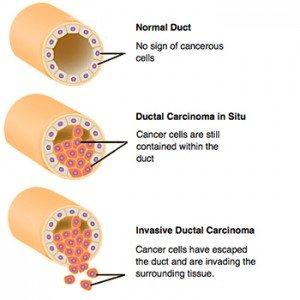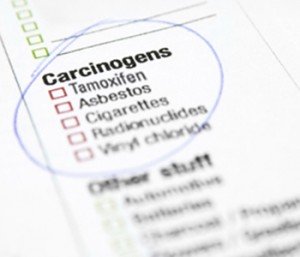Editor’s Note: This article first appeared in the Oct 2015 edition of TTAC’s Heroes Against Cancer member newsletter
Perhaps the hottest (and most confusing) health topic in the news lately is a condition known as DCIS or ductal carcinoma in situ. Many women only first learn about DCIS cancer when they get the shocking news that they have it.
This article will ask some important questions and help shed light on facts about DCIS that aren’t reported in the mainstream media or shared by most conventional medical doctors. It will educate and empower you with essential information so that if you are ever faced with DCIS, you are better prepared. You’ll learn what DCIS cancer really is, the limitations of conventional treatment options, as well as natural, non-toxic measures to possibly prevent and treat it.
Should you (or someone you love) be one of the 60,000 women each year that are faced with this confusing “cancer” diagnosis, the information here may very well save your breasts, your sanity, and even your life!
What is DCIS?

DCIS means the cancer is still contained in the ducts. IDC has begun to invade the surrounding tissue
Commonly known as “stage zero” breast cancer, DCIS is the acronym for ductal carcinoma in situ.
The term “in situ” means “in place.” The difference between DCIS and invasive breast cancer is that with DCIS, cancer cells have not invaded through the wall of the milk ducts. Invasive cancers have the ability to metastasize because its cells have access to the blood and lymphatic vascular systems. However, with DCIS the potential to metastasize may be held in check because its cells are confined inside the duct; hence the name “in situ.”
Sometimes DCIS is called “pre-cancer,” but this is misleading because most DCIS will not become invasive cancer. There are different grades of DCIS: low or grade I, moderate or grade II, and high or grade III. There is also DCIS-MI (DCIS with microinvasion). The higher the grade of DCIS, the higher the risk for invasive cancer.
Studies show that only high grade DCIS is likely to progress. Eighty percent or more of DCIS cases are considered “low risk” (low grade) and are not indicative of becoming invasive, yet doctors all too often group all DCIS together. In addition, studies show that a woman’s chance of dying of DCIS after 20 years, even with recurrence after a DCIS diagnosis, is only slightly above 3% – basically the same as the general population!
All of this creates a huge problem and one that often leads to over-treatment that is stressful, harmful and costly to the patient.
Could Finding DCIS Cancer Do More Harm Than Good?
While the surge in mammography screenings can certainly be credited with finding more cases of DCIS, not everyone agrees this is a good thing. Again, most cases of DCIS will never develop into cancer. Once DCIS is diagnosed (by a conventional medical doctor), it is common for a whirlwind of fear, confusion, and unnecessary over-treatment to begin for the patient.
Conventional medicine’s standard of care (their standard protocol) for DCIS includes aggressive cancer treatments, namely:
- Mastectomy or partial mastectomy
- Daily radiation treatments, often for several weeks
- The drug tamoxifen or similar drug to block estrogen, often prescribed for as long as 5-10 years
Using these conventional medical treatments for DCIS is like killing an ant with a sledge hammer and then throwing several bombs at it just to be sure you got the tiny, harmless insect!
These conventional cancer treatments are now being scrutinized and even labeled as over-treatment by many of the same conventional doctors that prescribe and administer them. Additionally, none of these standard of care treatments, no matter what the cancer, ever get to the underlying cause of the cancer.
Studies now show that more than one million women have been “over-treated” for DCIS over the last 30 years. In defense of conventional doctors, with breast cancer-related lawsuits being the most common cause of malpractice litigation in the US, it is no wonder radiologists, surgeons and oncologists have a bias to over-diagnose and over-treat. However, the emotional anguish and financial hardship created by over-treatment make this an enormous injustice in women’s health. Let us take a step back and take a rational look at the situation.
A Realistic Look at DCIS Breast Cancer
The body produces cancer cells on a daily basis, either from natural processes or otherwise. Thankfully, the immune system eliminates them and most times people never know these cancer cells came and went.
The problem is the immune system can become overwhelmed, leading to the development of cancer. In the case of DCIS, while the “cancer” is not invasive, and might never become problematic, it might require some sort of intervention or proactive measures. Why? Because DCIS, like many other conditions that raise the risk of invasive cancer, occurs as the result of exposure to emotional and environmental toxins (see below). Furthermore, it is suspected that cancer stem cells (CSCs) could already be present in DCIS.
The Role of Cancer Stem Cells

Broccoli sprouts are a particularly rich source of sulforaphane
Cancer stem cells are a small population of cancer cells within a tumor that are resistant to treatments such as chemotherapy and radiation, and are the only cancer cells that can metastasize. Even a small number of cancer stem cells can regenerate cancer elsewhere.
So while the malignant potential of cancer cells can be held in check given DCIS cells are confined inside the duct and do not have access to the blood and lymphatic system (which are both outside the duct), during biopsy and/or as a result of surgery, cancer cells can escape the duct.
Cancer stem cells and their resistance to conventional treatment are rarely discussed by the medical community but play a critical role in the progression of cancer. Understanding and addressing cancer stem cells can have a major impact on survival.
Thankfully, many natural compounds target CSCs. For example, research has shown that sulforaphane, abundant in foods such as broccoli and broccoli sprouts, can target cancer stem cells and can help prevent colonization of cancer cells. Curcumin, black cumin seed, vitamin D, and black and red raspberry are also effective.
Understanding How Epigenetics Affect DCIS Risk
Until recently, it was thought that our genes controlled our destiny. However, the new innovative field of study called epigenetics, is focused on how chemical reactions affect our DNA. Thanks to the work of researchers such as the late Dr. Mitchell Gaynor and Dr. Bruce Lipton, we now know that it is not the genes we were born with that determine our ultimate health and survival – our genetic expression is influenced by the foods we eat and the thoughts we think. Both our food and thoughts (and emotions we feel) impact the body’s chemical reactions, which over time can literally change the expression of our DNA.
Thus, a person can control his or her genetic destiny via lifestyle choices. For example, researchers have found that the sulforaphane (mentioned above) as well as other natural compounds can halt the expression of genes that inhibit DCIS from progressing and metastasizing.
Green tea, curcumin (from the herb turmeric), resveratrol (from red grapes and red wine), quercetin (from apples and citrus fruits), and watercress and other cruciferous vegetables such as Brussels sprouts, cauliflower, cabbage, and radish also contain compounds that affect gene expression.
So, could finding DCIS be doing more harm than good? It’s a fair question and it could be. Perhaps the real question, however, is: could treating DCIS with conventional treatments (namely breast amputation surgery, radiation, tamoxifen, or other similar estrogen receptor blocker drugs) be doing more harm than good?
Conventional DCIS Treatment: Does the Benefit Outweigh the Risk?
For women with low to moderate grade DCIS (grades I or ll), conventional standard of care treatment might not be the best plan of action. Proactive non-toxic interventions might be the better “treatment.” A diagnosis could be considered a wake-up call of sorts, indicating that perhaps there is a mental/emotional and/or physical issue that needs correcting.
Areas of suspicion can perhaps be better “treated” or dealt with by targeting CSCs and changing the cancer environment (and resulting gene expression). One might also consider working towards eliminating cancer cells within the duct with natural, non-toxic means.
Those with high (grade lll) or DCIS with microinvasion (DCIS-MI) who are uncomfortable with the non-removal of the area of concern might consider lumpectomy in conjunction with a more intensive protocol of non-toxic remedies and health-promoting efforts.
What Women Don’t Know About Conventional DCIS Treatments Can Hurt Them
Did you know that oncologists are legally bound to recommend conventional procedures whether or not they have any evidence to support their use? Standard of care medical treatments are consensus-based, not evidence-based. Consensus-based only means those treatments and protocols that are approved by the American Medical Association (essentially conventional doctors vote on them). It doesn’t necessarily even mean that the drugs or treatments work, or that they are the best options or better than alternative solutions.
While the benefits of conventional medical drugs and procedures are heavily promoted, all too often their limitations and potential dark sides are downplayed. Moreover, none of these conventional treatments address the potential underlying causes for DCIS. Environmental toxins, stress, nutritional deficiencies, and other triggers are absolutely critical to address!
Let’s now take a look at conventional medicine’s mandated standard of care for DCIS.
Screening Mammograms:

Screening mammograms have many associated risks
- Cause over-diagnosis (and over-treatment) in up to 54% of all “cancers” detected. Over-diagnosing of cancers that would never have caused symptoms or death can expose a woman to unnecessary damaging or harmful treatments.
- Miss 20 to 25% of invasive cancers (false negatives).
- Miss up to 75% of breast cancer in dense breasts.
- Use ionizing radiation and are carcinogenic which induces cancer and increases cancer risk by one% per year in premenopausal women.
- Result in “false-positives” in 50% of women screened annually for 10 years, which subjects women to unnecessary biopsies.
Biopsies:
While biopsies do provide patients and their doctors the information necessary to determine the extent of DCIS, there are potential issues to be aware of:
- May potentially “seed” or spread cancer cells. Anytime you remove cancerous cells you run the risk of releasing previously contained cells into the body (see the information on cancer stem cells above).
- Leave a titanium chip in the breast (which remains there indefinitely). Such chips can cause persistent itching, rashes, and pain, not to mention that many people prefer not to have metal permanently inserted into their body.
Surgery:
While many people take comfort in knowing that the DCIS has been removed, again, there are important things you need to know that you may not have heard from your medical team. Possible risks associated with surgery:
- Causes disfigurement, pain, infection, anxiety, scars, and scar tissue.
- Contributes to the spread of cancer. Surgery, as well as biopsies, can lead to the migration of cancerous cells.
- Statistics show that survival is equivalent with and without surgery for low-grade DCIS.
- Lumpectomies often fail to get clear margins and lead to re-excisions (second surgeries) 48 to 59% of the time.
- Statistics show that mastectomies offer no survival benefit over lumpectomies.
- Mastectomies sever nerves and cause loss of sensitivity (this is a big one when it comes to sexual enjoyment!).
- Increases risk of complications and/or death (all surgery comes with risk of death and complications).
- Studies show that pain medications such as morphine used during surgery can spur cancer growth.
- While surgery can remove DCIS, it does not address the risk factors that led to the development of DCIS in the first place.
Radiation Treatment:
Studies are mixed on the effectiveness of radiation for DCIS. Many studies have shown that radiation does more harm than good. Studies in favor of radiation have only cited statistics for 10 to 15 years. However, negative effects of radiation typically present 10 or more years post therapy, which is why long-term studies have not supported its efficacy. Other issues include:
- Can only be used once. Mastectomy is “necessary” if DCIS recurs.
- Produces free radicals and breaks chemical bonds causing damage and death to healthy cells/DNA – short term ramifications include burns and fatigue. Long-term effects include the formation of cancer.
- Increases risk of death; radiation is a known carcinogen, damages the heart, lungs, and other organs and may contribute to recurrence or new cancers, stroke, and heart disease.
- Does not correct the underlying reasons for the development of DCIS.
Tamoxifen:
While the m
- It is classified as a Group 1 “human carcinogen” by the International Agency for the Research on Cancer (part of the World Health Organization).
- May cause: blood clots in veins, lungs, or uterus; endometrial, colon and stomach cancer; cataracts, stroke, and fatty liver.
- Increases frequency of hot flashes, irregular periods or uterine bleeding; vaginal discharge, dryness or itching; reduces sex drive.
- Causes cognitive decline and dysfunction.
- Increases risk of a more aggressive ER-negative tumor in other breast.
- Offers no survival benefit.
- Does not correct the underlying causes for hormone imbalance that can support cancer growth.
All of these standard of care treatments are now being scrutinized and even labeled as overtreatment by many of the same conventional doctors that prescribe and administer them!
A Safer, Saner, Healthier Way to Treat DCIS
Below are five essentials to avoiding over-treatment, save your breasts, and live a long healthy, cancer-free life.
#1 – Understand epigenetics and take preventive measures that will positively affect gene expression.
- Eat healthy foods as mentioned earlier and avoid carcinogenic foods and environmental toxins that can potentially contribute to gene expression for cancer cells (see below for more on this).
- Address issues related to emotional trauma to minimize daily stress (see more below).
- Get enough deep, restorative sleep to detoxify and rejuvenate.

- Eat plenty of local, fresh, organic whole foods. Consume healthy fats. Avoid conventional meat and dairy products (look for grass-fed and organic). Drink filtered or pure spring water. Reduce or eliminate consumption of wheat which is typically genetically modified and treated with toxins such as Roundup.
- Consult with naturopathic and holistic practitioners: check for and reduce nutritional deficiencies, hormonal imbalances, teeth and gum issues, heavy metal toxicities, and inflammation that research has clearly shown to increase cancer risk.
- Consume foods rich in three key minerals: magnesium, selenium, and iodine, or consider supplementation. A deficiency in any or all of these can significantly raise your breast cancer risk.
- Reduce or eliminate exposure to environmental toxins and xenoestrogens from chemicals in home and personal care products, including BPA (found in plastics and on most cash register receipts).
- Reduce
stress: Substantial evidence indicates that long-term stress can cause permanent changes to genes. Make a daily habit of mindfulness, breathing, yoga, exercise, and relaxation.
- Practice lymphatic breast massage to increase the removal of toxins.
- Be respectful of the dangers of cellphone and other EMF radiation (electromagnetic fields). Do not carry a cell phone in your bra, breast pocket, or for that matter, anywhere on the body. Use air tube headsets or speaker mode to make and receive calls and keep your laptop off of your lap. Mounting research shows that EMF radiation from cell phones, laptop computers, and other electrical devices are associated with the development of cancer. The World Health Organization (WHO) has classified EMFs as a class B carcinogen.
- Work with a therapist or healer to resolve past emotional traumas that may be contributing to damaging physiological changes to DNA. Releasing trapped emotions and eliminating the bonds you have with events and people so you can leave such negative emotions in the past can play a major role in healing. There are many ways to do this:
- EFT tapping – a form of psychological acupressure that helps resolve emotional issues, cleaning out past traumas that contribute to dis-ease.
- Psychotherapy – an approach to wellness that recognizes the interconnection between mind, body, and spirit.
- Energy work – such as Qi Gong, Reiki, meditation, and distant or present energy healing.
Emotion Code – an energy technique that helps facilitate the release of trapped negative emotions.
#3 – Balance your hormones.
Hormone imbalances raise cancer risk significantly. Therefore, a positive result from hormone receptor testing usually precipitates a recommendation for hormone treatments. Once again, there is an opportunity for less toxic means for hormonal management:
- Natural compounds such as the sulforaphane in broccoli sprouts can help detoxify estrogen, and the supplement DIM (Diindolylmethane) assists with estrogen metabolism.
- Natural aromatase inhibitors i
nclude cooked button mushrooms (cooking removes naturally occurring toxins), pumpkin seeds, and flax seeds.
- Intravenous vitamin C therapy may help raise progesterone levels (progesterone is needed to oppose estrogen and maintain balance).
- Adrenal support via diet, exercise, and stress management will also help keep hormones in balance.
#4 – Use “individual” risk assessment tools.
Available tools can help patients make better treatment choices. However, it’s important to note that while statistics can be helpful to the clinician making recommendations, they do not apply to individuals. Every person and every cancer is different. However, the following may be helpful:
- National Cancer Institute’s Breast Cancer Risk Assessment Tool – a means to calculate risk based on statistics.
- The Van Nuys Prognostic Index – a scoring index used to determine the level of treatment to be recommended.
- The Oncotype DX for DCIS – a diagnostic test used to gain knowledge about a patient’s individual tumor.
- Her2/neu (human epidermal growth factor receptor 2) – 30% of DCIS overexpress Her2/neu, which is associated with an increased risk of recurrence.
#5 – Know ALL your treatment options.
Consider that “DCIS is cancer” is controversial, and aggressive conventional treatment may not be the best option for every individual. Depending on the grade of DCIS, a person has options that range from active surveillance, to natural, non-toxic treatments that support the body against the development of cancer, to less invasive surgery:
- Active surveillance (also known as “wait and watch”). Active surveillance may come with the downside of more frequent screening. Mammography is damaging, the contrast dye in MRIs can harm the kidneys, and thermograms and sonograms are inefficient at detecting DCIS (although sonograms can be effective for defining extent of DCIS).
However, some prefer a “wait and watch” option as it allows them to hold off on treatment unless the DCIS becomes more aggressive.
- Alternative, non-toxic treatments such as intravenous vitamin C, frankincense essential oil, glutathione, Traditional Herbal Chinese Medicine, Salvestrols, Laetrile, mistletoe, and others. Consult with a qualified coach or integrative doctor to find protocol options.
- Oncoplastic breast surgery offers lumpectomy and reconstruction as an alternative to mastectomy.
Now you know the true facts about DCIS. Should you or a loved one ever be faced with a diagnosis, you have information to choose between alternative and complementary therapies OR the conventional standard of care medical route. Remember that proactive measures can be taken to not only prevent DCIS, but also breast cancer itself.
Would you like to know ALL the ways to prevent, treat, and beat cancer? If so, you’ll love what you discover here.
Article Summary
Many women first learn about DCIS cancer (which stands for ductal carcinoma in situ) when given a diagnosis.
“In situ” means “in place.” With DCIS, cancer cells are held inside the wall of the milk ducts. Invasive cancers, on the other hand, have the ability to metastasize (spread) because the cells have access to the blood and lymphatic vascular systems.
There are different grades of DCIS and most DCIS will not become invasive cancer. However many doctors treat all DCIS the same which can lead to over-treatment. Studies now show that more than one million women have been “over-treated” for DCIS over the last 30 years.
Conventional standard protocol for DCIS includes aggressive cancer treatments including:
- Mastectomy or partial mastectomy
- Daily radiation treatments, often for several weeks
- The drug tamoxifen or similar drug to block estrogen, often prescribed for as long as 5-10 years
Cancer stem cells are the only cancer cells that can metastasize and are resistant to treatments such as chemotherapy and radiation. With DCIS these cells are often held in the milk duct wall, but during biopsy and/or surgery they can “escape” and spread.
5 essentials to avoiding over-treatment, saving your breasts, and living a long healthy, cancer-free life are:
- Understand epigenetics and take preventive measures that will positively affect gene expression
- Regularly incorporate holistic health and cancer prevention strategies
- Balance Your Hormones
- Use “individual” risk assessment tools
- Know ALL your treatment options
Depending on the grade of DCIS, treatment options range from active surveillance, to natural, non-toxic treatments that support the body against the development of cancer, to less invasive surgery.











 stress: Substantial evidence indicates that long-term stress can cause permanent changes to genes. Make a daily habit of mindfulness, breathing, yoga, exercise, and relaxation.
stress: Substantial evidence indicates that long-term stress can cause permanent changes to genes. Make a daily habit of mindfulness, breathing, yoga, exercise, and relaxation. nclude cooked button mushrooms (cooking removes naturally occurring toxins), pumpkin seeds, and flax seeds.
nclude cooked button mushrooms (cooking removes naturally occurring toxins), pumpkin seeds, and flax seeds.







Diagnosed with DCIS stage 0. What should I do?????
Hi Glenda,
The best advice we can give you is to consult with one of the doctors/experts that we interviewed in our Global Quest Series. Here is a link to get their information: https://thetruthaboutcancer.com/experts-info-sheet/
That is great advice to contact one of those doctors. The article was very informative. I only wish that I had seen it before I was scared into having surgery to remove the stage 0 DCIS that I was diagnosed with.
After my regular two yearly mammogram I was diagnosed with DCIS 2 years ago. At that appointment I was informed another mammogram was required and at that time a titanium marker was inserted into the cluster of microcalcification in my left breast. I was then told that I was to be scheduled for a lumpectomy in a weeks time followed by chemotherapy. It was presumed by the surgeon and nurse that I would be pleased to have this problem resolved quickly. Thankfully because of this presumption “there dear we know best” I decided to get another opinion. I read up and sought out a breast surgeon who would agree to monitor me through an initial MRI and a mammogram, with no invasive surgery or chemotheraphy.
I read how the Japanese woman have the lowest rate of breast cancer because of their high iodine intake through their diet. I commenced and have been taking iodine in the form of drops and now use a roll on transdermal Lugol iodine check to ensure my levels remain at a safe and optimum level. The results are astounding there was no evidence of any DCIS at the first six monthly mamogram after my initial diagnosis. I am now monitored with a annual mammogram .
Thanks for sharing, Margaret!
Hi Margret, I just read your comment, that’s great! I was wondering, what level of DCIS did you have? I was diagnosed this year with DCIS high grade, and was recommended to have a mastectomy. I’m a bit skeptical and was interested in alternatives.
Thanks
Is your DCIS that serious that you need chemotherapy?
Thanks for your info….what grade of Dcis did you have?
If mammograms are potentially harmful, what are the alternatives and does insurance generally cover these?